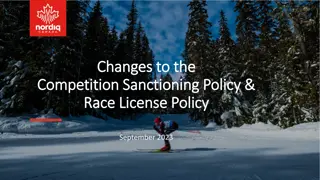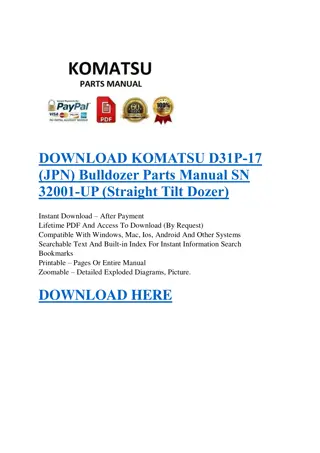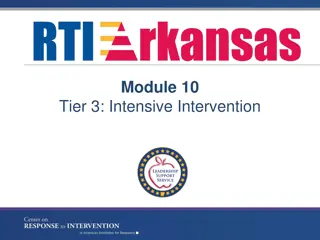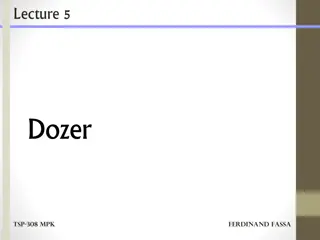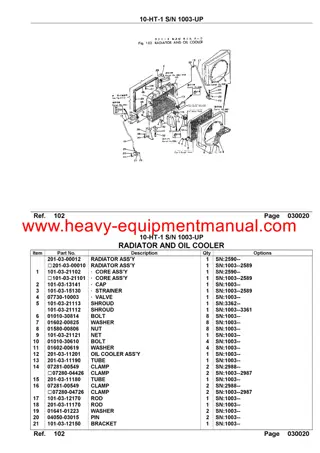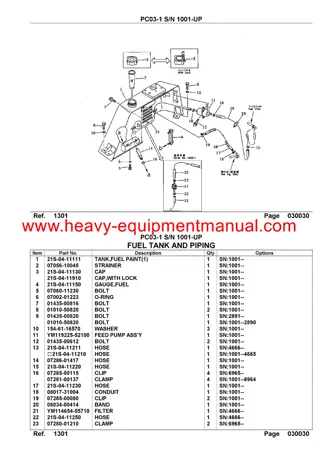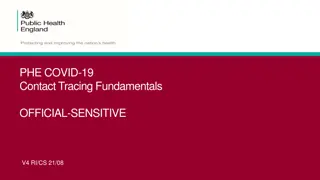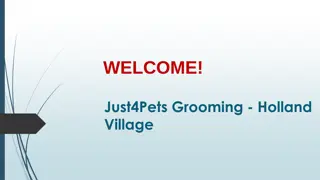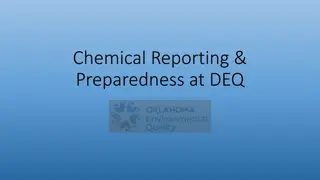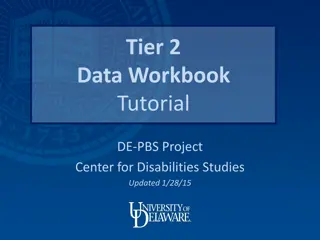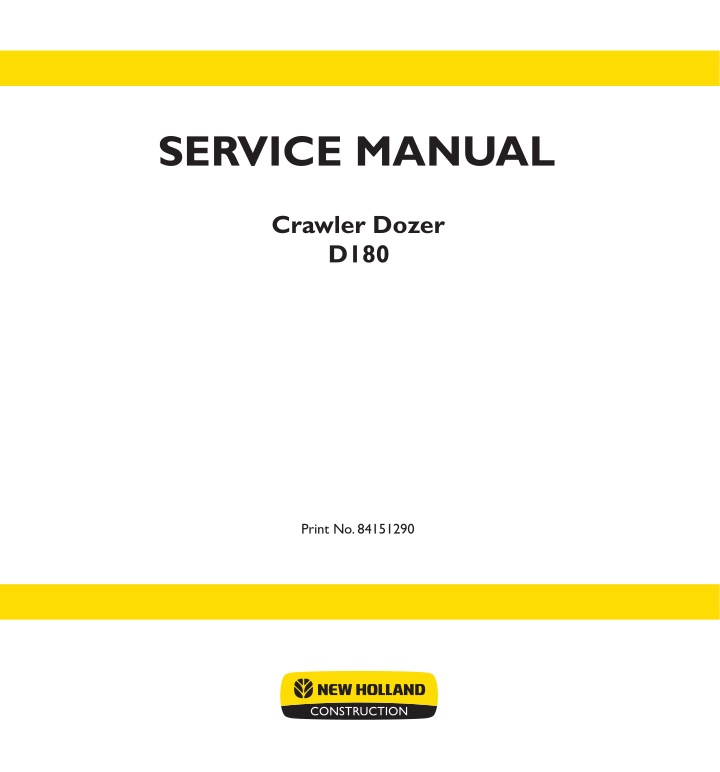
NEW HOLLAND D180 TIER 3 CRAWLER DOZER Service Repair Manual Instant Download
NEW HOLLAND D180 TIER 3 CRAWLER DOZER Service Repair Manual Instant Download
Download Presentation

Please find below an Image/Link to download the presentation.
The content on the website is provided AS IS for your information and personal use only. It may not be sold, licensed, or shared on other websites without obtaining consent from the author. If you encounter any issues during the download, it is possible that the publisher has removed the file from their server.
You are allowed to download the files provided on this website for personal or commercial use, subject to the condition that they are used lawfully. All files are the property of their respective owners.
The content on the website is provided AS IS for your information and personal use only. It may not be sold, licensed, or shared on other websites without obtaining consent from the author.
E N D
Presentation Transcript
SERVICE MANUAL Crawler Dozer D180 Print No. 84151290
D180 (Tier 3) CRAWLER DOZER Workshop Manual Print No. 84151290 English THISALERTSYMBOLSIGNALSIMPORTANTMESSAGESINVOLVINGYOURSAFETY. Read and heed carefully the safety instructions listed and follow the precautions recommended to avoid potential risks and to safeguard your health and your safety. You will find this symbol in the text of this Manual referred to the following key words: WARNING - Cautions directed to avoid improper repair interventions involving potential consequences for the safety of the personnel performing the repairs. DANGER - These warnings qualify specifically potential dangers for the safety of the operator or other persons directly or indirectly involved. IMPORTANT NOTICE All maintenance and repair interventions explained in this Manual must be performed exclusively by the Service Organisation of the Manufacturer, observing strictly the instructions explained using, whenever necessary, the recommended specific tools. Whoever performs the operations reported without following exactly the precautions is responsible on his own, for the damages that may result. Neither the Factory nor any Organisations in its Distribution Network, including but not limited to national, regional or local distributors, are responsible for any liability arising from any damage resulting from defects caused by parts and/or components not approved by the Factory for use in maintaining and/or repairing products manufac- tured or merchandised by the Factory. In any case, no warranty of any kind is made or shall be imposed with respect to products manufactured or merchandised by the Factory, when failures are caused by the use of parts and/or components not approved by the Factory.
AVOID ACCIDENTS Most accidents, whether they occur in industry, on the farm, at home or on the road, are caused by the failure of some individuals to follow simple and fundamental safety rules and precautions. For this reason MOST ACCI- DENTS CAN BE PREVENTED by recognising the real cause and doing something aboiut it before the accident occurs. Regardless of the care used in the design and construc- tion of any type of equipment, there are many conditions that cannot be completely safeguarded against without interfering in the reasonable accessibility and efficient operation. A carefull operator is the best insurance against an accident. The complete observance of one simple rule would prevent many serious accidents. The rule is simple: never attempt to clean, lubricate or maintain a machine while it is in motion. WARNING Prior to engaging in any maintenance, adjustment or repair operation on machines having hydrauli- cally, mechanically, and/or cable controlled equip- ment (such as shovels, loaders, dozers, excavators etc.) be certain the equipment is lowered to the ground. If it is necessary to have the equipment partially or fully raised to gain access to certain items, be sure the equipment is suitably supported by means oth- er than the devices used for controlling the equip- ment.
SUMMARY GENERALITIES SECT. 0 ENGINE SECT. 1 TRANSMISSION SECT. 2 FINAL DRIVES SECT. 3 BRAKES AND STEERING DIFFERENTIAL - D180 POWER STEERING SECT. 4 BRAKES AND STEERING CLUTCHES - D180 STEERING CLUTCHES SECT. 4 BIS UNDERCARRIAGE SECT. 5 DOZING EQUIPMENT - HYDRAULIC SYSTEM D180 PS SECT. 6 DOZING EQUIPMENT - HYDRAULIC SYSTEM D180 SC SECT. 6 BIS ELECTRICAL SYSTEM SECT. 7 AIR CONDITIONING UNIT SECT. 8 D180-3R001
https://www.ebooklibonline.com Hello dear friend! Thank you very much for reading. Enter the link into your browser. The full manual is available for immediate download. https://www.ebooklibonline.com
SECTION 0 GENERALITIES TABLE OF CONTENTS SUBJECT PAGE SAFETY RULES ..........................................................................................................................................I-VIII IDENTIFICATION DATA Engine data plate........................................................................................................................................ 0-3 Vehicle Identification Plate .......................................................................................................................... 0-4 Marking and serial number.......................................................................................................................... 0-4 TABLE OF FLUID CAPACITIES..................................................................................................................... 0-5 DIMENSIONS D180 BD ................................................................................................................................ 0-6 DIMENSIONS D180 PAT ............................................................................................................................... 0-7 Technical data D180 PS - D180 SC............................................................................................................ 0-8 D180 POWER STEERING LGP .................................................................................................................. 0-24 D180 POWER STEERING LT/XLT - STEERING CLUTCHES LT/XLT ............................................................ 0-25 WEIGHT AND EQUIPMENT D180 PAT........................................................................................................ 0-26 WEIGHT MACHINE D180 PAT .................................................................................................................... 0-26 LIST OF WEIGHTS FOR MAIN SERVICE COMPONENTS ..........................................................................0-27 CENTRE OF GRAVITY TABLE.....................................................................................................................0-29 GENERAL INSTRUCTIONS..........................................................................................................................0-30 TROUBLESHOOTING ..................................................................................................................................0-35 UNITS OF MEASURE ..................................................................................................................................0-36 TABLE OF TIGHTENING TORQUES ............................................................................................................0-38
WARNING Study carefully this Manual before starting, operating, maintaining, fuelling or servicing the machine. Read and heed all safety rules before any intervention. SAFETY RULES - Do not allow unauthorised personnel to operate service or maintain this machine. Before operating a machine, always ensure that any unsafe condition has been satisfactorily remedied. - Do not wear rings, wrist watches, jewellery, loose or hanging apparels, such as ties, torn clothing, scarves, unbuttoned or unzipped jackets that can catch on mov- ing parts. Wear proper safety equipment as recom- mended for the job. Examples: hard hat, heavy gloves, ear protection, safety glasses or goggles, reflector vests, respirator. Consult your employer for specific safety equipment requirements. - Check brakes, steering and attachment controls before moving. Advise the proper maintenance authority of any malfunctioning part or system. - Be sure all protective guards or panels are in place, and all safety devices provided are in place and in good operating conditions. - Be sure exposed personnel in the area of operation are clear of the machine before moving it or its attachments. WALK COMPLETELY AROUND the machine before mounting. Sound horn. - Keep operator's compartment, stepping points, grab- rails and handles clear of foreign objects, oil, grease, mud or snow accumulation to minimise the danger of slipping or stumbling. Clean mud or grease from shoes before attempting to mount or operate the machine. - Before starting machine, check, adjust and lock the operator's seat for maximum comfort and control of the machine. - Do not jump on or off the machine. Keep two hands and one foot, or two feet and one hand in contact with step grab rails and handles at all times. - Fasten your seat belt (when provided). - Do not use controls or hoses as hand holds when climbing on or off machine. Hoses and controls are movable and do not provide a solid support. Also, controls may be inadvertently moved causing accidental machine or equipment movement. - Obey all flag signals and signs. - Due to the presence on the machine of flammable fluids, never check or fill fuel reservoirs or batteries near open flames, smoking materials or sparks. - Never attempt to operate the machine or its tools from any position other than seated in the operator's seat. - REMEMBER THAT STARTING FLUID IS FLAMMABLE. Follow strictly the recommendations printed on contain- ers and in the Operation and Maintenance Manual. - Keep head, body, limbs, hands and feet inside opera- tor's compartment at all times, to reduce exposure to hazards outside the operator's compartment. - DO NOT PUNCTURE OR BURN CONTAINERS. - Containers must be stored in fresh, well ventilated plac- es, out of reach of unauthorised persons. Follow strictly the instructions provided by the Manufacturer. - Be careful of slippery conditions on stepping points, hand rails, and on the ground. Wear safety boots or shoes that have a high slip resistant sole material. - Never use these products near open flames, smoking materials or sparks. - Do not leave the machine until it is completely stopped. - Check the seat safety belt at least twice a year. If there are signs of wear or fraying or other signs of weakness that could lead to failure, replace it. OPERATION - Do not run the engine of this machine in closed areas without proper ventilation to remove deadly exhaust gases. STARTING - NEVER START NOR OPERATE AN UNSAFE MA- CHINE. - Roll Over Protective Structures are required on loaders, dozers, graders, excavators. I
SAFETY RULES NEVER OPERATE machines without ROPS. Keep cab windows clean and repaired. - Make sure the Operator's compartment is free of foreign objects, especially if not firmly secured. Never use the machine to transport objects, unless proper securing points are provided. - When machines are operating in tandem, the pusher (rear) must be equipped with the appropriate deflectors to protect the unit in front from the air stream coming from the radiator. - When pulling or towing through a cable or chain, do not start suddenly at full throttle; take-up slack carefully. - Check monitoring instruments at start-up and frequently during operations. in case the brake pressure gauge shows a pressure lower than the minimum operating pressure, stop immediately the machine . Inspect carefully for flaws or troubles before using. - Avoid kinking chains or cables. Do not pull through a kinked chain or cable to the high stresses and possibility of failure of the kinked area. Always wear heavy gloves when handling chains or cables. - DO NOT CARRY RIDERS ON MACHINE - Study and familiarise with escape routes alternate to normal exit routes. - Be sure chains and cables are anchored and the anchor points are strong enough to handle the expected load. Keep exposed personnel clear of anchor points and cables or chains. - Seat belts are required by current regulations to be provid- ed with Roll Over Protection Structures or cabs. Keep safety belts fastened around you during operation. - For your personal protection, do not climb on or off machine while machine is in motion. - DO NOT PULL UNLESS OPERATOR's COMPARTMENT OF MACHINES INVOLVED ARE PROPERLY GUARDED AGAINST POTENTIAL CABLE OR CHAIN BACKLASH. - Make sure that exposed persons in the area of operation are clear of the machine, before starting the engine and operating the equipment. Sound horn. Obey all indications provided by flags and signals. - Be alert to soft ground conditions close to newly construct- ed walls. The fill material and weight of the machine may cause the wall collapse under the machine. - NEVER COAST the machine down grades and slopes with the transmission in neutral or neutralised. - In darkness, check area of operation carefully before moving in with machine. Use all lights provided. Do not move into area of restricted visibility. Choose and shift into the most appropriate gear to keep the speed required, thus preventing any loss of control. - If engine has a tendency to stall for any reason under load or idle, report this for adjustment to proper maintenance authority immediately. Do not continue to operate ma- chine, until condition has been corrected. - Do not operate machinery in a condition of extreme fatigue or illness. Be especially careful towards the end of working shift. - Do not operate machine with brakes out of adjustment. - On machines supplied with suction radiator fans, be sure to periodically check engine exhaust parts for leaks, as exhaust fumes are dangerous to the operator. - Operate the machine at speeds slow enough to ensure complete control at all times. - In case of closed type cabs, always keep an opening with the outside, to ensure a constant air circulation. - Travel slowly over rough terrain, on slopes or near drop- offs, in congested areas or on ice or slippery surfaces. - Operators must know thoroughly the performances of the machine they are operating. When working on slopes or near sudden level drops of the terrain, avoid areas where ground is loose or soft since rolling-over or loss of control of machine could result. - When backing, always look to where the machine is to be moved. Be alert to the position of exposed personnel. DO NOT OPERATE if exposed personnel enter the immediate work area. STOP THE MACHINE. - Maintain a safe distance from other machines. Provide sufficient clearance for ground and visibility conditions. Yield right-of-way to loaded machines. - Where noise exposure exceeds 90 dBA for 8 hours, wear approved ear protection. - When counterweights are provided, do not work machine if they have been removed. - Maintain clear vision of areas of travel or work. II
SAFETY RULES - Avoid operating equipment too close to an overhang or high wall, either above or below the machine. Be on the look-out for caving edges, falling objects and slides. Beware of concealment by brush and undergrowth of these danger. - Overtaking manoeuvres must be performed only when absolutely necessary and unavoidable. Beware of possi- ble uneven terrains, poor visibility conditions, the pres- ence of other machinery or persons out of sight. - Operate the machine at a speed adequate to the working conditions in the site and slow enough to ensure complete control at all times. - When pushing-over trees, the machine must be equipped with proper overhead guarding. Never allow a machine to climb up on the root structure particularly while the tree is being felled. Use extreme care when pushing over any tree with dead branches. - Never use the machine as a work platform or scaffolding, nor other inappropriate operations (i.e. pushing railway cars, trucks or other machines). - When pushing trees with dead limbs, proceed with ex- treme care. Avoid brush piles, logs or rocks. - Be alert of people in the operating area of the machine. - NEVER DRIVE OVER THEM or other surface irregulari- ties that brake traction with the ground, especially when on slopes or near drop-offs. - When operating a machine, know in advance what clear- ances will be encountered, overhead doors, cables, pipes, bearing load limitations of ground, bridges, floors or ramps. - Be alert to avoid changes in traction conditions that could cause loss of control. DO NOT DRIVE on ice or frozen ground conditions when working the machine on steep slopes or near drop-offs. - When roading, find-out what conditions are likely to be encountered, clearances, traffic congestion, type of road surfacing, etc. Beware of fog, smoke or dust elements that obscure visibility. - Working in virgin and rough terrains is characterised by the presence of all the perils and risks listed above. In these conditions, it is emphasised the danger represented by large tree limbs (possibly falling on the machine), large roots (acting as a leverage under the machine when up- rooted causing the roll-over of the unit) etc.. - When crossing gullies or ditches, move at an angle with reduced speed after ensuring ground conditions will per- mit a safe traverse. - Explore the working area to identify potential risks such as: slopes, overhangs, pits, demolition rubble, fires, ravines, ditches, soft terrain, heavy traffic, crowded parking areas, closed ambients. In such conditions, proceed with ex- treme care. - Whenever possible, avoid going over obstacles such as rough terrain, rocks, logs highly irregular ground, steps, ditches, railroad tracks. When obstructions must be crossed, do so with extreme care at an angle, if possible. Reduce speed, shift-down. Ease up to the break over point, pass the balance point slowly on the obstruction and ease down on the other side. STOPPING - When the machine is stopped for whatever reason, follow the instructions of chapters "Stopping the machine" and "Stopping the engine" of the Operation and Maintenance Instruction Manual. - Always remember to position the transmission drive control in neutral and engage the control lock to secure the machine. - In steep down-hill operation, do not allow engine to over- speed. Select proper gear before starting down grade. - The parking brake is automatically set, when the transmis- sion safety lever is lowered. - Avoid side hill travel, whenever possible. Drive up and down the slope. Should the machine slipping sideways, turn it immediately downhill. - NEVER LEAVE THE MACHINE UNATTENDED with the engine running. - The grade of slope you should attempt will be limited by factors such as condition of the ground, load being han- dled, type of machine, speed of machine and visibility. - Always, before leaving the operator's seat and after mak- ing sure all people are clear of the machine, slowly lower the attachments or tools flat to the ground in a positive ground support position. - There is no substitute for good judgement when working on slopes. III
SAFETY RULES - Return the controls to rest position. Place the gearshift lever in neutral. Disconnect the master switch and extract the key. - Keep operator's compartment free of all loose objects that are not properly secured. - Do not wear rings, wrist watches, jewellery, loose or hanging apparels, such as ties, torn clothing, scarves, unbuttoned or unzipped jackets that can catch on mov- ing parts. Wear proper safety equipment as recom- mended for the job. Examples: hard hat, heavy gloves, ear protection, safety glasses or goggles, reflector vests, respirator. Consult your employer for specific safety equipment requirements. - Park in a non- operating and no-traffic area or as instruct- ed. Park on firm level ground if possible. Where not possible, position machine at a right angle to the slope, making sure there is no danger of uncontrolled sliding movements. - If parking in traffic lanes cannot be avoided, provide appropriate flags, barriers, flares and signals as re- quired. Also provide advance warning signals in the traffic lane of approaching traffic. - Do not use controls or hoses as hand holds when climbing on or off machine. Hoses and controls are movable and do not provide a solid support. Also, controls may be inadvertently moved causing accidental machine or equipment movement. - Keep head, body, limbs, feet, fingers or hands away from bucket, blade or ripper when in raised position. - Always disconnect the master switch before any inter- vention (i.e. cleaning, repairing, maintaining, refuelling etc.). Do the same when parking for prolonged periods of time to avoid accidental or unauthorised starting. - Do not jump on or off the machine. Keep two hands and one foot, or two feet and one hand in contact with step grab rails and handles at all times. - Do not perform any service operation on the machine with a person seated in the operator's compartment, unless he is an authorised operator co-operating in the operation to be performed. - Never lower attachments or tools other than seated in operator's seat. Sound horn. Make sure area near the attachment is clear. Lower the attachment slowly. DO NOT USE FLOAT POSITION of hydraulic system. - Keep operator's compartment, stepping points, grab- rails and handles clear of foreign objects, oil, grease, mud or snow accumulation to minimise the danger of slipping or stumbling. - Place master switch in OFF, securely block the machine and lock it every time you leave it unattended. Return keys to authorised security. Heed all shut-down opera- tions of the Operation and Maintenance Instruction Manual are followed. Clean mud or grease from shoes before attempting to mount or operate the machine. - Keep shoes free of mud or grease before climbing or driving the machine. - Never attempt to operate the machine or its tools from any position other than seated in the operator's seat. MAINTENANCE - When maintenance operations require moving hydrau- lically operated attachments by means of machine's hydraulic system remember that all manoeuvres must be made only when seated in the operator's seat. Before starting machine or moving attachment or tools, set brakes , sound horn and call for an all clear. Raise attachment slowly. GENERALITIES - Before operating or performing any intervention on the machine: read carefully all the rules contained by this Manual; - Always block booms or parts of the machine which must be raised to perform interventions under them with external devices. Do not allow persons to move into the vicinities nor standing under equipment not being blocked. Unless you are totally sure about your safety, avoid staying under raised equipment, even in case it is blocked. read and obey all safety related plates and instructions located on the machine. - Do not allow unauthorised personnel to perform any maintenance operation. Do not perform maintenance operation without prior authorisation. Follow all recom- mended maintenance and service procedures. IV
SAFETY RULES - Never align holes with fingers or hands; always use appropriate aligning tools. - Do not place the body, limbs or fingers into sharp articulation uncontrolled openings of the machine and without proper protections, unless they are blocked in a safe manner. - Eliminate all sharp edges and burrs from re-worked parts. - Never perform interventions with engine running, except as called for in a Manual. Do not wear loose clothing or jewellery near moving parts. - Use only approved grounded auxiliary power sources for heaters, chargers, pumps and similar equipment to reduce the hazards of electrical shocks. - When servicing or maintenance require access to areas that cannot be reached from the ground, use a ladder or step platform that meet local and national regulations, to reach the service point. If such ladder or platform are not available, use the machine hand holds and steps as provided. Perform all service or maintenance carefully. - Lift and handle heavy parts with a lifting device of proper capacity. Be sure parts are supported by proper slings and hooks. Use lifting eyes if provided. Watch-out for people in the vicinity. - Never pour gasoline or diesel fuel into open, wide and low containers. Never use gasoline, solvent or other flammable fluid to clean parts. Use exclusively qualified, non-flammable, non-toxic commercial solvents. - Shop and/or field service platforms or ladders must be constructed and maintained in accordance with local and national regulations. - When using compressed air for cleaning parts, use safety glasses with side shields or goggles. Limit pres- sure to 2 bar, in accordance with local and national regulations. - Disconnect batteries and tag all controls according to current regulations to warn that work is in progress. Block machine and all attachments that must be raised according to current regulations. - Do not run the engine in closed areas without proper ventilation to remove deadly exhaust fumes. Due to the presence of flammable fluids, never check or fill fuel tanks, batteries, nor use starting fluid near lighted smoking materials or open flames. - Do not smoke or permit any open flames or spark near when re-fuelling or handling flammable materials. - BRAKES ARE INOPERATIVE when manually released for servicing. Provisions must be made to maintain control of the machine by blocking or other means. - Do not use an open flame as a light source to look for leaks or for inspection anywhere on the machine. - The fuel filling nose must be kept constantly inside the filling neck. Keep this contact from the beginning to the end of the fuelling operation to avoid the possibility that sparks due to static electricity are generated. - Make sure that all mechanic's tools are in good condi- tions. NEVER USE tools with mushroomed heads or frayed. Always wear eye protections. - Move with extreme care when working under the ma- chine, its attachments and or on or near them. Always wear protective safety equipment as required, such as hard hat, goggles, safety shoes, ear plugs. - Use only designated towing or attaching points. Use care in making attachments. Make sure pins and/or locks are secure before pulling. Stay clear of drawbars, cables or chains under load. - When performing operations requiring running of the engine, have a qualified operator in the operator's seat at all times with the mechanic on sight. Place the trans- mission in neutral and set the brakes and safety lock. - To move a disabled machine, use a trailer or a low-boy, if available. In case towing is needed , use all necessary signals required by local and national regulations, and follow the directions provided in this Manual. - KEEP HANDS AND CLOTHING AWAY FROM MOVING PARTS. - To load/unload a machine from transporter, choose a level surface ensuring firm support to the wheels of truck or trailer. Use strong access ramps, with adequate height and angle. Keep surface free of mud, oil or slippery materials. - For field service, move machine to level ground, if possible, and block it. If work on an incline is abso- lutely necessary, first block machine and its attach- ments securely, than move it to level ground as soon as possible. - Anchor the machine securely to the bed of truck or trailer and block wheels or tracks with appropriate wedges. V
SAFETY RULES - Do not trust worn and /or kinked chains and cables: do not use them for lifting or pulling operations. To handle them, always use heavy gloves. - The load lifted by jacks is always dangerous: it is necessary to transfer loads to appropriate blocking as a safety measure, before proceeding with service or maintenance work, according to local or national regulations. - Be sure chains and cables are anchored and the anchor points are strong enough to handle the expected load. Keep exposed personnel clear of anchor points and cables or chains. - Steel cables are frayed after prolonged use; always wear appropriate protections (heavy gloves, goggles etc.). - No bystanders are allowed near the hooking points, chains or cables. - Handle all parts carefully. Keep hands and fingers away from structures, gears or moving parts. Use and wear always the appropriate protections - DO NOT PULL UNLESS OPERATOR's COMPART- MENT OF MACHINES INVOLVED ARE PROPERLY GUARDED AGAINST POTENTIAL CABLE OR CHAIN BACKLASH. - Compressed air systems can have water deposits creat- ed by moisture condensation due to changes of atmos- pheric conditions. If required, discharge deposits, as instructed. - Keep the area where maintenance operations are per- formed CLEAN and DRY. Eliminate immediately all water and oil spillages. STARTING - Do not pile oily or greasy rags; they represent a fire hazard. Store in closed metal container. - Do not run the engine in closed areas without proper ventilation to remove deadly exhaust fumes. - Before starting machine, check, adjust and lock the operator's seat for maximum comfort and control of the machine. Be sure exposed personnel in the area of operation are clear of the machine before moving it or its attachments. Sound horn. - Do not place head, body, limbs, feet, hands or fingers, near rotating fans or belts. Be especially alert near pusher fans. - Rust inhibitors are volatile and flammable Use only in well ventilated areas. Keep open flames away - DO NOT SMOKE - Store containers in a cool well ventilated place, secure against unauthorised personnel. ENGINE - Loosen the radiator cap very slowly, to release pressure from the system, before removing it. All coolant level top- ups must be performed with engine OFF. - Do not carry loose objects in pockets that might fall unnoticed into open compartments. - Avoid that flammable materials touch exhaust parts. Should this be possible, provide the necessary protec- tions. - Wear proper protective equipment such as safety gog- gles or safety glasses with side shields, hard hat, safety shoes, heavy gloves when metal or other particles are apt to fly or fall. - Do not run engine when refuelling and use care if the engine is hot due to the increased possibility of a fire if fuel is spilled. - Wear welders protective equipment such as dark safety glasses, helmets, protective clothing, gloves and safety shoes, when welding or burning. Wear dark safety glasses near welding zones. - Never attempt to check or adjust fan belts when engine is running. DO NOT LOOK AT ARC WITHOUT PROPER EYE PROTECTION. - Do not adjust engine fuel pump when machine is mov- ing. - Know your jacking equipment and its capacity. Be sure the jacking point used on the machine is appropriate for the load to be applied. Be sure the support of the jack at the machine and under jack is appropriate and stable. - Do not lubricate the machine with engine running. - Do not run the engine with air intakes, door or protections open. VI
SAFETY RULES ELECTRICAL SYSTEM - Stop the engine and release all pressures in the system before removing panels, housings, plugs or covers. - Disconnect batteries prior to any intervention on ma- chine or electrical system (cleaning, repair, mainte- nance). - In case pressures must be measured, use instruments of adequate capacity. Always follow the recommended procedures. - Should booster batteries be used, remember to connect both ends of the booster cables in the proper manner (+) with (+) and (-) with (-). Avoid short-circuits of the termi- nals. Follow thoroughly the instructions of this Manual. TOOLS - Keep head, body, limbs, feet, fingers or hands away from bucket, blade or ripper when in raised position. - Before any intervention, make sure that the main switch is OFF. Prior to any intervention, install all safety devices accord- ing to current rules and regulations. - BATTERY GAS IS HIGHLY FLAMMABLE. Leave bat- tery box open to improve ventilation when recharging batteries. Never check charge by placing metal objects across the posts. Keep sparks or open flames away from batteries. Do not smoke near battery to guard against the possibility of causing an explosion. - In case equipment on the machine must be operated by hydraulic systems, remember to proceed only after seating in the operator's compartment. Make sure that there are no persons in the operating area of the machine. Alert people before operating using the horn and by voice. Move the equipment very carefully. - Before any intervention, make sure that there are no fuel or electrolyte leakages; eliminate them before proceed- ing with further work. When recharging batteries in closed ambients, make sure that there is appropriate ventilation to prevent possible accidental explosions due to the accumulation of gases generated during the recharge. - Do not use machine to transport loose objects, unless proper devices for this purpose are provided. - Clutches and brakes of this machine and eventual aux- iliary equipment and attachments (such as operating cylinder or winches control valves) must always be properly adjusted in accordance with the instructions provided by the Manuals of the Manufacturer. HYDRAULIC SYSTEM - Fluid escaping under pressure from a very small hole can be almost invisible and can have sufficient force to penetrate the skin. Use a piece of cardboard or wood to search for suspected pressure leaks. DO NOT USE HANDS. If injured by escaping fluid, see a doctor at once. Serious infection or reaction can develop if proper medical treatment is not administered immediately. - Never perform adjustments with engine running, except when called for by the above instructions. When changing work shift, check that wheel or rim securing screws and brackets are not loosen; if neces- sary, retighten to the prescribed torque. WARNING On machines having hydraulically, mechanically, and/or cable controlled equipment (such as shovels, loaders, dozers, excavators etc.) be certain the equipment is lowered to the ground before servicing, adjusting and/or repairing. If it is necessary to have the hydraulically, mechanically, and/or cable con- trolled equipment partially or fully raised to gain access to certain items, be sure the equipment is suitably supported by means other than the hydraulic lift cylinders, cable and/or mechanical devices used for controlling the equipment. VII
SAFETY RULES SAFETY RULES FOR SEALS VITON SEALS (fluoroelastomer) Seals, especially VITON O-Rings, (normally coloured red) are used in systems operating at high temperatures, since this materials resists the effects of heat. However, in the event this material is subject to heat exceeding 315 C (599 F) (in practice, only in case of fire or when using welding flames) fluoridic acid is generated. This acid is highly corrosive and could cause severe burns, if in contact with the skin. Every time it is necessary to intervene on components equipped with VITON rings, for which an exposure to excessive temperatures is suspected, the following proce- dures must be applied: 2) identify the type of material of the seals, if they are VITON, performing the test illustrated below, on the spare parts; 3) in case it is verified, or there is a reasonable doubt that the components are made of VITON, the contaminated area MUST be decontaminated before proceeding with further operations; 4) wear neoprene rubber or PVC gloves and protection goggles or face screen, and wash accurately the con- taminated zone with a solution of hydraulic lime (found at building stores) and water, so that a milky liquid is obtained. Rinse carefully with steam or running water; 5) dispose of the materials removed and the protective gloves in a safe manner, without burning them. 1) inspect visually, without touching them, all seals show- ing signs of damage due to high temperature. They look black and tacky; TEST FOR THE DISCRIMINATION OF RUBBER (BUNA N) MATERIALS AND "VITON" (FLUOROELASTOMER) MATERIAL WATER WATER TRICHLORO- ETHYLENE NITRILIC/BUNA N RUBBER VITON" FLUOROELASTOMER FLOATS SINKS VIII
D180 DOZERS TECHNICAL DATA TABLES
D180 0 - 3 IDENTIFICATION DATA A. Engine data plate The engine data plate is visible by opening the engine left side panel and it includes all the identification data and other important information related to the engine. Record the information below for quick reference in case of necessity. IMPORTANT ENGINE INFORMATION This engine conforms to 2003 U.S. EPA And California Tier 3 and EU Stage III regulations for heavy duty non-road compression ignition diesel cycle engines as applicable. THIS ENGINE IS CERTIFIED TO OPERATE ON DIESEL FUEL MODEL No. SERIAL No. DATE CODE 1850-M0044 Carefully read personal and machine SAFETY PRECAUTIONS at the beginning of this Manual
D180 0 - 4 B. Machine identification plate The identification plate includes the main data of the machine and it is visible under the operator's seat. Record the data of your machine below. TECHNICAL TYPE/MODEL UNIT SERIAL No. YEAR D180-2M171 C. Marking and serial number On the right side of the transmission housing it is possible to read the MARKING of the machine, com- posed of: - manufacturer code (the first three digits) FNH; - machine code (5 digits); - check letter "N"; - year of production 6 for 2006; - manufacturing plant "H" (Lecce Plant); - lproduct line "C" (Dozer); - machine serial number (last 5 digits). D180-2M172 MODEL MARKING D180 LT (Power Steering) *FNH183LTN6HC44001* D180 XLT (Power Steering) *FNH183XTN6HC45001* D180 LGP (Power Steering) *FNH183LPN6HC46001* D180 LT (Clutch) *FNH183B1N6HC47001* D180 XLT (Clutch) *FNH183B2N6HC48001* Carefully read personal and machine SAFETY PRECAUTIONS at the beginning of this Manual
Suggest: If the above button click is invalid. Please download this document first, and then click the above link to download the complete manual. Thank you so much for reading
TABLE OF FLUID CAPACITIES D180 ITEM QUANTITY (Litres) Fluids and lubricants VISCOSITY GRADE Outdoor temperatures of reference International Classification Mixture of water and antifreeze at 50%. The mixture provides oxidation, foaming, corrosion, scaling and freezing protection properties down to - 35 C (-31 F). Cooling system 24 Agrifl Down to -35 C (-31 F) Carefully read personal and machine SAFETY PRECAUTIONS at the beginning of this Manual Fuel reservoir 400 DIESEL FUEL ASTM No. 2D Grade TT of reputable quality and make SAE 10W - 30 SAE 15W - 40 -25 to 20 C (-13 to 68 F) -15 to 40 C (-5 to 104 F) MasterGold HSP API CH4 - ACEA 5 API CF-4/SG or MIL-L-2104E Engine 19 SAE 10W - 30 SAE 15W - 40 -25 to 25 C (-13 to 68 F) 15 to 40 C (-5 to 104 F) SuperGold SAE 10W All season Torque converter Transmission 48 Hydropower ATF Type A Suffix A Transmission housing 70 steering/brakes Super Gold API CF-4/SG or CCMC D4 or MIL-L-2104 E SAE 10W - 30 -25 to 20 C (-13 to 68 F) Hydraulic system Hi - Tech 46 Hydrosystem 46 HV DIN 51524 PART - 1 DIN 51524 PART - 2 ISO VG 46 -20 C to 50 C (- 4 to 122 F) "BULLDOZER" equipment D180 Power Steering D180 with ripper or ISO 46 116 121 Final drives (each) 33 Hypoide 90 SAE 80W - 90 All season API GL5 or MIL-L-2105 Idlers 7 Super Gold API CF-4/SG or CCMC D4 or MIL-L-2104 E SAE 10W - 30 -25 to 20 C (-13 to 68 F) Rollers and track chains Grease fittings GR9 NH 710A - NLGI2 All season Cab tilting pump 0.5 Hydropower SAE 10W All season ATF Type A Suffix A If the content of sulphur of the fuel exceeds 0.5 %, change the engine oil as follows: Notes: - Oil quantities indicated are those required for periodical changes. - In case of a lower classification of CH4 engine oil, the change must be done every 250 hours. - The change interval must be reduced when present sulfur in the fuel exceed to 0,5% or the ambient temperature exceed to 38 C. Down to 0,5 % sulphur Periodical change 0 - 5 from 0,5 to 1 % Half normal interval Over 1 % One quarter normal interval
https://www.ebooklibonline.com Hello dear friend! Thank you very much for reading. Enter the link into your browser. The full manual is available for immediate download. https://www.ebooklibonline.com

